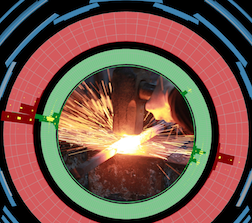Inflection-point inflation is a unique possibility to realize a successful slow-roll inflation
when inflation is driven by a single scalar field with an initial value below the Planck mass.
In order for a re-normalization group (RG) improved effective $\lambda(\phi) \phi^4$ potential
to develop an inflection point, the self-coupling $\lambda(\phi)$ must exhibit a minimum
with an almost...
I will overview the main characteristics of primordial helical fields. I will discuss the (nearby) scale invariant helical magnetic fields generated during inflation. It will be shown that if magnetic helicity of such fields is measured, it can be used to determine the beginning of inflation. Upper bounds on magnetic helicity can be used to derive constraints on the minimal duration of...
It is usually assumed that the inflationary fluctuations start from the Bunch-Davies (BD) vacuum and the iε prescription is used when interactions are calculated. We show that those assumptions can be verified explicitly by calculating the loop corrections to the inflationary two-point and three-point correlation functions. Those loop corrections can be resumed to exponential factors, which...
Observable primordial tensor modes in the cosmic microwave background (CMB) would point to a high scale of inflation $H_{I}$. If the scale of Peccei-Quinn (PQ) breaking $f_a$ is greater than $\frac{H_{I}}{2\pi}$, CMB constraints on isocurvature naively rule out QCD axion dark matter. This assumes the potential of the axion is unmodified during inflation. We revisit models where inflationary...
Axion stars are condensed states of large numbers of axion particles, bound by self-gravitation and attractive self-interactions. Such states generically arise in theories of light scalars, where the critical temperature for the transition is very high. By solving the semiclassical equations of motion, we find the maximum gravitationally stable mass for weakly bound axion stars. Further, the...
If the dark matter particles are axions,
gravity can cause them to coalesce into axion stars,
which are stable gravitationally bound systems of axions.
In the previously known solutions for axion stars,
gravity and the attractive force between pairs of axions are
balanced by the kinetic pressure.
The mass of these dilute axion stars cannot exceed a critical mass,
which is about...
The discovery of the Higgs boson marks a key ingredient to establish the electroweak structure of the Standard Model. Its non-abelian gauge structure gives rise to, yet unobserved, non-perturbative baryon and lepton number violating processes. We propose to use cosmic ray air showers, as mea- sured, for example, at the Pierre Auger Observatory, to set a limit on the hadronic production cross...
The search for the origin(s) of ultra-high energy (UHE) cosmic rays (CR) remains one of the cornerstones of high energy astrophysics. The previously proposed sources of acceleration for these UHECRs were gamma-ray bursts (GRB) and active galactic nuclei (AGN) due to their energetic activity and powerful jets. However, a problem arises between the acceleration method and the observed CR...
